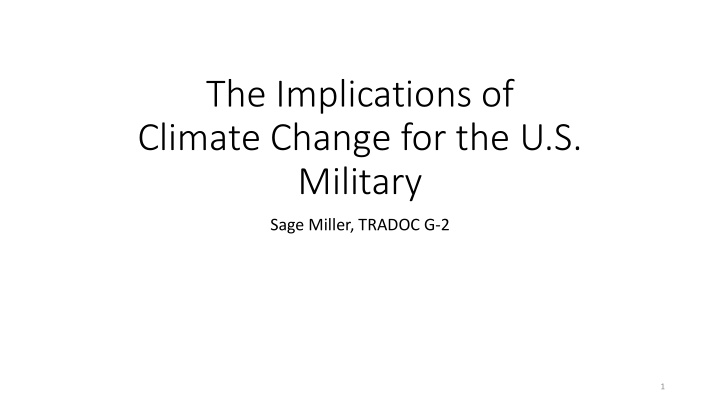



The Implications of Climate Change for the U.S. Military Sage Miller, TRADOC G-2 1
The Science of Climate Change • Global temperature rise • Warming oceans • Ocean acidification • Shrinking ice sheets • Glacial retreat • Sea level rise • Extreme events 2
Overarching Implications 1. New areas of competition 2. Effects on the Joint Force 3. New drivers of conflict 3
New Areas of Competition: The Arctic • Melting ice caps will lead to: • Increased tourism • Increased shipping • Resource exploitation/extraction • Military activity • Main competitors in the region: • Russia • China 4
New Areas of Competition: Global Fishing Grounds • As global sea temperatures rise, fish are migrating to search for better oxygenated water and larger food sources • 80% of the world’s fish stocks are currently overfished or at maximum capacity • Has caused recent rifts between multiple states • Iceland and Norway • Competition over migrating fish has the potential to increase tensions in a warming South China Sea 5
Effects on the Joint Force: Spread of Disease • Increased heat and precipitation are changing disease vectors, which will pose new threats to troops as diseases spread • Military personnel who work in the field will be among the most at-risk • Outbreaks will increase in frequency and intensity • Melting permafrost will slowly release diseases into the atmosphere that we are ill-equipped to deal with 6
Effects on the Joint Force: Installations Threatened • Climate change threatens key bases both at home and abroad • Recurrent flooding, drought, desertification, wildfires, and thawing permafrost all pose dangers currently and in the future • Impacts: • Interrupts training • Degrades equipment faster • Weakens ISR in certain regions 7
Effects on the Joint Force: New Types of Training and Missions • Increased military presence in the Arctic will mean greater Arctic training • Training for extreme weather conditions: extreme cold, extreme heat, etc. • Increased humanitarian missions and disaster relief 8
New drivers of conflict: Mass Migration • By 2050, climate change could force more than 143 million people to move within their countries in just three regions: • Southeast Asia • Sub-Saharan Africa • Latin America • The poorest and most vulnerable areas will be the hardest hit 9
New drivers of conflict: Mass Migration • Migration will result in millions of people flocking to urban areas, compounding other problems such as resource scarcity and increasing the potential for civil unrest • Already vulnerable areas and states will be pushed to the tipping point and may be plunged into conflict 10
Resource scarcity → Conflict and Instability There are several instances in which resource scarcity has helped lead to conflict: Syrian Civil War Arab Spring Boko Haram 11
Five Key Takeaways 1. More humanitarian missions 2. More disaster response missions at home 3. Readiness of Army is threatened 4. Increase in resource competition 5. Greater likelihood for conflict worldwide 12
Looking Forward • Other countries can exploit climate change to their advantage; weaponization of the effects is already occurring • The U.S. will be able to exploit new weaknesses of different enemies that occur as climate change continues/worsens • However, the U.S. must also be aware of the dangers that climate change poses to its operations and installations, and accordingly prepare to operate within these changing conditions 13
Recommend
More recommend